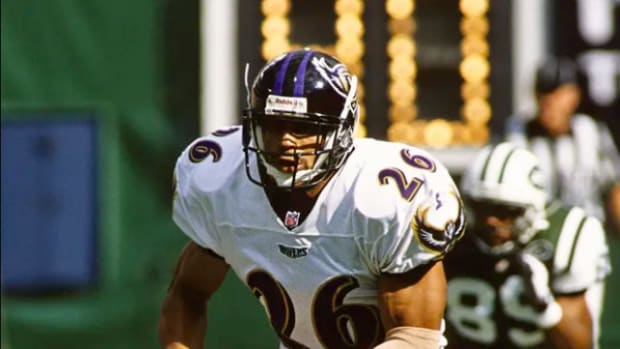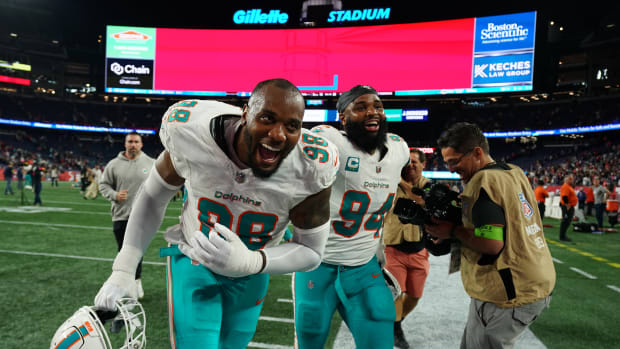How the Wins Piled Up for Lamar Jackson’s Ravens
Last season, NFL insiders marveled at how the Texans coaching staff remade its offense to accommodate rookie quarterback Deshaun Watson. Significant chapters of head coach Bill O’Brien’s classic Patriots-style playbook were replaced by hybrid college-pro style designs, with the Texans featuring a medley of misdirection and designed QB movement.
It was the most impressive on-the-fly coaching adjustments we’d seen. That is, until this year. In Baltimore, public discourse has first centered on the Joe Flacco vs. Lamar Jackson debate, and second on whether the first-round rookie quarterback can continue being an electrifying run-first quarterback without becoming the next Robert Griffin. What gets lost: These conversations are only happening place because of the tremendous on-the-fly adjustments made by John Harbaugh and his staff, especially offensive coordinator Marty Mornhinweg.
Mornhinweg hails from the Andy Reid coaching tree and, in his heart of hearts, probably yearns to sling the ball up and down the field. But Baltimore does not have Kansas City’s weapons, and for much of last season and parts of this season, Mornhinweg struggled to find the right balance in aerial designs with Flacco. Thankfully, this past offseason Mornhinweg and his assistants—notably QBs coach James Urban and tight ends coach Greg Roman (a run game aficionado)—had the foresight to write a few playbook pages for Jackson, even though Jackson was not expect to be ready for a fulltime role until 2019.
But when Flacco injured his hip in Week 9, the Ravens had to expand those Jackson playbook pages into entire chapters. That has spawned the most creative and diverse rushing attack in pro football—in Jackson’s five starts the Ravens are averaging just under 47 rushing attempts per game. This offense now utilizes myriad read-option designs that features not just Jackson’s legs but—equally as important—the threat of his legs, which skews a defense’s box count and makes linebackers play tentatively. Magnifying this is the array of ghost reverse, jet-sweep and orbit motion looks (in other words, wide receivers sprinting from one side of the field to the other, bringing extra dimensions to the run plays). With all this, the Ravens are employing more pull-blockers and “sift” blockers, with linemen and tight ends working across the formation, sometimes in the direction the ball is going, other times in the opposite direction.
These are dizzying, confounding looks for a defense, which is why shortly after Jackson stepped in, the Ravens made a change at tailback: Out was Alex Collins, a known Irish dancer who sometimes let that hobby spill into his running style, in was undrafted rookie Gus Edwards, who is as basic a runner as the league has ever seen but aims to execute each play exactly as designed.
QB STOCK WATCH: Flacco and the Ravens Could Be Heading Toward a Split
After wearing down the Bucs with 242 yards from that ground game Sunday, en route to a fourth victory in five outings with Jackson, the Ravens are now averaging a mind-blowing 230 rushing yards a week since Jackson was inserted. The offensive line, which has been sound all year in pass protection but struggled early on to generate movement on the ground, is playing better, as the expanded designs have made for slower defenders (i.e. easier blocking targets) and presented more favorable angles on many run-blocks.
The question is: How long can this approach continue to work? We’ve seen other teams inject a mobile QB and gain a schematic step as defenses are ill-equipped to adjust midseason. But for an offense like that not to dry up, it must build a passing game off those run designs. That’s what O’Brien and the Texans did so well (and quickly) in their short time with Watson last year. But Watson as a rookie was a much more refined passer than Jackson is now—which is saying something since Watson himself, scintillating as his passing can be, still has room to grow.
Jackson does not have Watson’s deep-ball ability, and he doesn’t see throwing lanes as sharply as Watson does when moving outside the pocket. That on-the-move passing must improve if Jackson is to have a fruitful career. It’s not an overnight endeavor, though, so in the meantime, Mornhinweg and his staff must focus on expanding their passing game in ways that Jackson can execute now. That means throws between the numbers, where Jackson has been proficient if not outright excellent at times. Jackson burned the Bucs with some critical slant completions, which he had thrown well in recent outings. He also added some seam balls, which are new to his repertoire. Slants and seams are the routes most commonly incorporated into run-pass-options (RPOs). Expect more down the stretch.
Also expect more play-action, which present only half-field reads for Jackson. The beauty there is that the half-field read has only one or two options, encouraging a QB to run if the looks aren’t clean. Jackson is a swift scrambler, and those scramble yards can be viewed as de facto check-down completions (that’s how Seahawks coaches looked at it when Russell Wilson was young).
This isn’t the best formula for Jackson’s long-term success—a quality veteran starter is never referred to as a “scramble-centric, half-field read guy.” But it is the best formula for Jackson’s immediate success, which makes it the best formula for the 2018 Ravens’ success. That’s what Harbaugh, Mornhinweg and this staff will think about first and foremost, if not exclusively. Because if the Ravens’ “immediate success” doesn’t continue into January, it could be a different staff scheming with Jackson next year.
• Question or comment? Email us at talkback@themmqb.com.




































